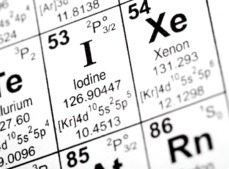Iodine (I)

Iodine is an element of vital importance to all higher animals and is frequently found to be deficient in UK, Irish and European soils, except on windward coastal regions where sea spray contains enough to make a difference. A deficiency in the soil leads to a deficiency in grass and crops and the situation is made worse by eating goitrogenic (antithyroid) crops such as white clovers and brassicas.
There are many symptoms of iodine deficiency in livestock, ranging from enlarged thyroid (goitre), high neo-natal death rates, born weak or with poor hair/wool covering, to hypothermia in young animals. Infertility, retained placentas and footrot are a few symptoms showing in adults. The cost to a livestock operation relating to iodine deficiency is many times the cost of preventing the situation from arising.
At least 50% of dairy herds are known to be deficient and this can be detected by analysing milk. Milk iodine levels are roughly proportional to the level of dietary iodine. Bearing in mind the growing awareness of a significant iodine deficiency problem in the human population, good iodine levels in dairy cow forage would result in improved herd health, good iodine levels in dairy products and good PR for the industry.
Iodine Deficiency Symptoms in Livestock
Poor hair and wool at birth
Poor heat detection
Susceptibility to hypothermia (low thyroxine production)
High neo-natal death rate
Weak, sickly young animals
Poor fertility
Retained afterbirth
